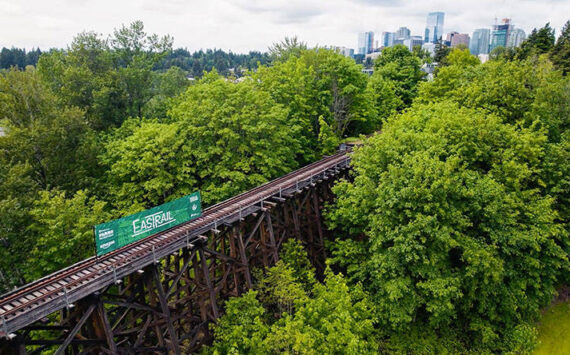Why is there surprise that monorail opposition is heating up? (See “It’s a Fight to the Finish,” p. 11.) The pro-monorail folks are acting like the Bush people, shocked that there’s discontent in Iraq. They’re replying to critics with a defense that’s summed up as “just build it!”
But a question remains: What is “it”?
That lack of a clear picture is partly by intention. When voters approved the Green Line, many aspects of the project were left undecided. This was partly to get people to buy a general concept that could be refined later, with community input. It was also done to dodge more problematic elements. The monorail was approved narrowly, and it’s clear that if the pro-monorail campaign had been too explicit about some details, it might never have passed. At the time of the vote, in November 2002, we were still being told by Tom Weeks, who today is the Seattle Popular Monorail Authority board chairman, that preservation of the old monorail was still on the table—an idea ditched almost immediately after passage. Also, important parts of the route were undecided.
True, there was a lot to figure out, and the monorail folks hadn’t had the time or budget or authority to do it before that election. With any big project, you have to get into it a bit before you know what you’re really facing. Now, the monorail people know. Their plan is rapidly coming together. Decisions have been made. So, for the first time, the public is getting a chance to see what we’re buying, and whether or not we want a refund.
That’s as it ought to be: Massive public works projects like the monorail and Sound Transit should come with a guarantee at least equal to Nordstrom’s return policy.
In many ways, the monorail has proceeded as a response to the city’s love of process: It wouldn’t have gotten this far without careful attention to the grass roots, constituent neighborhoods, property owners, and businesses. The downside of this approach is that there are winners and losers every step of the way, people who lobbied harder and won, and people who fought and lost, some who won’t be happy no matter what. But the strength of the monorail’s process might be a weakness in the plan: A city of shopkeepers is influencing the design, block by block. No wonder parts of the route seem to pinball through the city, while others take the path of least resistance.
Adding to the complexity is the fact that the monorail is a public/private partnership—the kind of concept usually touted by Republicans but embraced here in one of the nation’s most liberal cities. The reason “just build it” is no answer is that the stakes are so high for the future of the city given the power invested in the private side—whichever company is ultimately selected to design, build, and operate the system. This approach reduces risk in the construction phase. However, the monorail will guarantee the line’s operator an ongoing profit and assume all the risk of operational deficits, a huge potential liability. That might be OK if we didn’t see everywhere an endless appetite on the part of private entrepreneurs (like sports franchise owners) to fob off all risk on the public and a proven lack of stewardship on the part of our public watchdogs.
The public liability is magnified in the long run by the fact that the Green Line only makes sense as part of a larger system that runs citywide and becomes a true, workable alternative for car and bus riders. If the Green Line stands alone, it will cost us all to benefit only a few. Building it citywide will take additional billions of dollars and will work only if it radically transforms development patterns in the city by driving growth into monorail corridors. While even our earliest settlers looked to replicate big Eastern cities—New York Alki—it’s a sure bet that most people today live in Seattle because it is decidedly not New York. Oh, it works in Osaka? Have you been to Osaka? Most Seattleites would declare it an uninhabitable metropolis.
Most newcomers to the region choose to live in areas that are less urban than Seattle. Radically pumping up the city’s population densities is a questionable goal and may not be workable without massive subsidy. It was a noble idea in the lost battle to contain sprawl, but it’s not what the market wants. Nor what the laws encourage. The state Growth Management Act allows way too much growth in areas designated as “urban,” yet that after development still offer densities and amenities that are appealingly suburban.
The monorail true believers have drunk the Kool-Aid. They see every half-empty glass as three-quarters full. They tell us the huge revenue shortfall is actually a good thing, forcing them to design a better, smarter system. Following that to its logical conclusion, the only thing better than small or smallest is nonexistent. The debate in between is a good thing, an opportunity to have a realistic, last-minute hard look at what we’re about to do. That involves good old-fashioned Seattle second-guessing. For those who say the current derailing effort smacks of Schwarzenegger-style politics, one might simply refer them to the R.H. Thomson Expressway, the massive 1960s project that would have ringed Seattle with freeway. Voters approved it, then changed their minds. The legacy of R.H. Thomson are those Highway 520 off-ramps to nowhere near the Arboretum, where a freeway was stopped dead in its tracks. I pass those ramps every day, and for me they’re monuments to a saner, sensible Seattle, a city I hope hasn’t completely disappeared.








